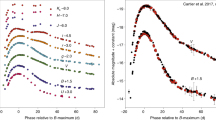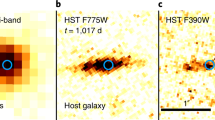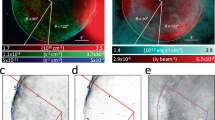Abstract
During the lifetime of our Milky Way galaxy, there have been something like 100 million supernova explosions, which have enriched the Galaxy with the oxygen we breathe, the iron in our cars, the calcium in our bones and the silicon in the rocks beneath our feet. These exploding stars also influence the birth of new stars and are the source of the energetic cosmic rays that irradiate us on the Earth. The prodigious amount of energy (∼1051, or ∼2.5 × 1028 megatonnes of TNT equivalent) and momentum associated with each supernova may even have helped to shape galaxies as they formed in the early Universe. Supernovae are now being used to measure the geometry of the Universe, and have recently been implicated in the decades-old mystery of the origin of the γ-ray bursts. Together with major conceptual advances in our theoretical understanding of supernovae, these developments have made supernovae the centre of attention in astrophysics.
This is a preview of subscription content, access via your institution
Access options
Subscribe to this journal
Receive 51 print issues and online access
$199.00 per year
only $3.90 per issue
Buy this article
- Purchase on Springer Link
- Instant access to full article PDF
Prices may be subject to local taxes which are calculated during checkout


Similar content being viewed by others
References
Woosley, S. E. & Weaver, T. A. The evolution and explosion of massive stars. II. Explosive hydrodynamics and nucleosynthesis. Astrophys. J. Suppl. 101, 181–235 (1995).
Nomoto, K. & Hashimoto, M. Pre-supernova evolution of massive stars. Phys. Rep. 163, 13– 36 (1988).
Bethe, H. A., Brown, G. E., Applegate, J. & Lattimer, J. M. Equation of state in the gravitational collapse of stars. Nucl. Phys. A324, 487–533 ( 1979).
Taylor, J. H. & Cordes, J. M. Pulsar distances and the galactic distribution of free electrons. Astrophys. J. 411, 674–684 (1993).
Nomoto, K. Evolution of 8-10 solar mass stars toward electron capture supernovae. I—Formation of electron-degenerate O + Ne + Mg cores. Astrophys. J. 277, 791–805 (1984).
Perlmutter, S. et al. Measurements of Omega and Lambda from 42 high-redshift supernovae. Astrophys. J. 517, 565– 586 (1999).
Riess, A. et al. Observational evidence from supernovae for an accelerating universe and a cosmological constant. Astron. J. 116, 1009–1038 (1998).
Tueller, J. et al. Observations of gamma-ray line profiles fro SN 1987A. Astrophys. J. 351, L41–L44 (1990).
Arnett, W. D., Bahcall, J. N., Kirshner, R. P. & Woosley, S. E. Supernova 1987A. Annu. Rev. Astron. Astrophys. 27, 629–700 (1989).
Woosley, S. E. & Hoffman, R. D. The alpha-process and the r-process. Astrophys. J. 395, 202– 239 (1992).
Iyudin, A. F. et al. Emission from 44Ti associated with a previously unknown galactic supernova. Nature 396, 142–144 (1998).
Burbidge, E., Burbidge, G., Fowler, W. A. & Hoyle, F. Synthesis of the elements in stars. Rev. Mod. Phys. 29, 547–650 (1957).
Colgate, S. A. & Johnson, H. J. Hydrodynamic origin of cosmic rays. Phys. Rev. Lett. 5, 235– 238 (1960).
Burrows, A. & Mazurek, T. J. Postshock neutrino transport and electron capture in stellar collapse. Astrophys. J. 259, 330–340 (1982).
Bruenn, S. W. Stellar core collapse—Numerical model and infall epoch. Astrophys. J. Suppl. 58, 771–841 (1985).
Colgate, S. A. & White, R. H. The hydrodynamic behavior of supernovae explosions. Astrohys. J. 143, 626– 681 (1966).
Bethe, H. E. & Wilson, J. R. Revival of a stalled supernova shock by neutrino heating. Astrophys. J. 295, 14–23 (1985).
Wilson, J. R. in Numerical Astrophysics (eds Centrella, J. M., LeBlanc, J. M. & Bowers, R. L.) 422–435 (Jones & Bartlett, Boston, 1985).
Burrows, A. & Lattimer, J. M. Convection and the early evolution of neutron stars. Phys. Rep. 925, 51– 62 (1988).
Burrows, A. & Lattimer, J. M. The birth of neutron stars. Astrophys. J. 307, 178–196 (1986).
Bionta, R. M. et al. Observation of a neutrino burst in coincidence with supernova 1987A in the Large Magellanic Cloud. Phys. Rev. Lett. 58, 1494–1496 (1987).
Hirata, K. et al. Observation of a neutrino burst from the supernova SN1987A. Phys. Rev. Lett. 58, 1490–1493 (1987).
Burrows, A. Supernova neutrinos. Astrophys. J. 334, 891–908 (1988).
Totani, T., Sato, K., Dalhed, H. E. & Wilson, J. R. Future detection of supernova neutrino burst and explosion mechanism. Astrophys. J. 496, 216–225 ( 1998).
Koshiba, M. The Kamiokande Detector. Phys. Rep. 220, 229–231 (1992).
Ewan, G. T. et al. Sudbury Neutrino Observatory Proposal (Report SNO-87-12, 1987).
Bellotti, E. Instrum. Meth. A264, 5–9 (1988).
LVD Collaboration. Nucl. Instrum. Meth. A264, 5–21 ( 1988).
Icarus Collaboration. Icarus Proposal (LNGS Note 94/99-I, INFN preprint, GranSasso Laboratory, 1994).
Mayle, R. & Wilson, J. R. Supernovae from collapse of oxygen-magnesium-neon cores. Astrophys. J. 334, 909– 926 (1988).
Burrows, A., Hayes, J. & Fryxell, B. A. On the nature of core-collapse supernova explosions. Astrophys. J. 450, 830– 850 (1995).
Messer, O. E. B., Mezzacappa, A., Bruenn, S. W. & Guidry, M. W. A comparison of boltzmann and multigroup flux-limited diffusion neutrino transport during the postbounce shock reheating phase in core-collapse supernovae. Astrophys. J. 507, 353–360 (1998).
Burrows, A. & Goshy, J. A theory of supernova explosions. Astrophys. J. 416, L75–L78 (1993).
Fryer, C. & Heger, A. Core-collapse simulations of rotating stars. http://xxx.lanl.gov/archive/astro-ph/9907433 ( 1999).
Turatto, M. et al. The peculiar type II supernova 1997D: A case for a very low 56Ni mass. Astrophys. J. 498, L129 –L133 (1998).
Sollerman, J., Cumming, R. J. & Lundquist, P. A very low mass of 56Ni in the ejecta of SN 1994W. Astrophys. J. 493, 933– 939 (1998).
Bethe, H. A. & Brown, G. E. A scenario for a large number of low-mass black holes in the galaxy. Astrophys. J. 423 , 659–664 (1995).
Brown, G. E., Weingartner, J. C. & Wijers, R. A. M. J. On the formation of low-mass black holes in massive binary stars. Astrophys. J. 463, 297–304 (1996).
Herant, M., Benz, W., Hix, R., Fryer, C. & Colgate, S. A. Inside the supernova: A powerful convective engine. Astrohys. J. 435, 339– 361 (1994).
Janka, H.-T. & Müller, E. Neutrino heating, convection, and the mechanism of Type-II supernova explosions. Astron. Astrophys. 306, 167–198 ( 1991).
Fryxell, B. A., Müller, E. & Arnett, D. Instabilities and clumping in SN 1987A. I—Early evolution in two dimensions. Astrophys. J. 367, 619–634 (1991).
Wooden, D. H. et al. Airborne spectrophotometry of SN 1987A from 1.7 to 12.6 microns—Time history of the dust continuum and line emission. Astrophys. J. Suppl. 88, 477–507 ( 1993).
Wang, L., Wheeler, J. C. & Höflich, P. Polarimetry of the type Ia supernova SN 1996X. Astrophys. J. 476, L27–L30 (1997).
Lyne, A. & Lorimer, D. R. High birth velocities of radio pulsars. Nature 369, 127– 129 (1994).
Cordes, J. M., Romani, R. W. & Lundgren, S. C. The Guitar nebula—A bow shock from a slow-spin, high-velocity neutron star. Nature 362, 133–135 (1993).
Fryer, C., Burrows, A. & Benz, W. Population syntheses for neutron star systems with intrinsic kicks. Astrophys. J. 496, 333–351 (1998).
Piro, L. in Joint European and National Astronomical Meeting, JENAM-97, 6th European and 3rd Hellenic Astronomical Conference 284–287 (Univ. Thessaloniki, 1997).
Harrison, T. E. & McNamara, B. J. The optical counterparts of gamma-ray bursts. Nature 396, 233–236 (1998).
Costa, E. et al. Discovery of an X-ray afterglow associated with the γ-ray burst of 28 February 1997. Nature 387, 783 –785 (1997).
van Paradijs, J. et al. Transient optical emission from the error box of the γ-ray burst of 28 February 1997. Nature 386, 686 –689 (1997).
Metzger, M. R. et al. Spectral constraints on the redshift of the optical counterpart to the γ-ray burst of 8 May 1997. Nature 387, 879–881 (1997).
Paczynski, B. Gamma-ray burst-supernova relation. http://xxx.lanl.gov/archive/astro-ph/9909048 (1999).
Reichart, D. E. GRB 970228 revisited: Evidence for a supernova in the light curve and late spectral energy distribution of the afterglow. Astrophys. J. 521, L111–L115 (1999).
Bloom, J. S. et al. The unusual afterglow of the gamma-ray burst of 26 March 1998 as evidence for a supernova connection. Nature 401, 453–456 (1999).
Galama, T. J. et al. An unusual supernova in the error box of the γ-ray burst of 25 April 1998. Nature 395, 670– 672 (1998).
Woosley, S. E., Eastman, R. G. & Schmidt, B. P. Gamma-ray bursts and type Ic supernova SN 1998bw. Astrophys. J. 516, 788– 796 (1999).
Woosley, S. E. Gamma-ray bursts from stellar mass accretion disks around black holes. Astrophys. J. 405, 273–277 (1993).
Wheeler, J C., Yi, I., Höflich, P. & Wang, L. Asymmetric supernovae, pulsars, magnetars, and gamma-ray bursts. http://xxx.lanl.gov/archive/astro-ph/9909293 (1999).
Ostriker, J. P. & Gunn, J. Do pulsars make supernovae? Astrophys. J. 164, L95– L96 (1971).
MacFadyen, A. & Woosley, S. E. Collapsars: Gamma-ray bursts and explosions in “failed supernovae”. Astrophys. J. 524, 262–289 (1999).
Schmidt, B. P. et al. The high-Z supernova search: Measuring deceleration and global curvature of the universe using type Ia supernovae. Astrophys. J. 507, 46–63 ( 1998).
Hamuy, M. BVRI light curves for 29 type Ia supernovae. Astron. J. 112, 2408–2437 (1996).
Turner, M. S. & Tyson, J. A. Cosmology at the millennium. Rev. Mod. Phys. 71, 145 (1999 ).
Steinhardt, P. J., Zlatev, I. & Wang, L. Quintessence, cosmic coincidence, and the cosmological constant. Phys. Rev. Lett. 82, 896–899 (1999).
Phillips, M. M. The absolute magnitudes of Type Ia supernovae. Astrophys. J. 413, L105–L108 (1993).
Suntzeff, N. et al. Optical light curve of the type Ia supernova 1998bu in M96 and the supernova calibration of the hubble constant. Astron. J. 117, 1175–1184 ( 1999).
Gibson, B. K. et al. The HST key project on the extragalactic distance scale XXV. A recalibration of cepheid distances to type Ia supernovae and the value of the hubble constant. http://xxx.lanl.gov/archive/astro-ph/9908149 (1999).
Kennicutt, R. C. Jr., Freedman, W. L. & Mould, J. R. Measuring the hubble constant with the Hubble space telescope. Astron. J. 110, 1476–1491 (1995).
Sakai, S. et al. The Hubble space telescope key project on the extragalactic distance scale XXIV: The calibration of Tully-Fisher relations and the value of the hubble constant. http://xxx.lanl.gov/archive/astro-ph/9909269 ( 1999).
Chaboyer, B., Demarque, P., Kernan, P. J. & Krauss, L. M. A lower limit on the age of the universe. Science 271 , 957–961 (1996).
Chaboyer, B., Demarque, P., Kewrnan, P. J. & Krauss, L. M. The age of globular clusters in light of Hipparcos: Resolving the age problem? Astrophys. J. 494, 96– 110 (1998).
Cowan, J. et al. R-process abundances and chronometers in metal-poor stars. Astrophys. J. 521, 194–205 (1999).
Aguirre, A. Dust versus cosmic acceleration. Astrophys. J. 512, L19–L22 (1999).
Umeda, H., Nomoto, K., Kobayashi, C., Hachisu, I. & Kato, M. The origin of the diversity of type Ia supernovae and the environmental effects. Astrophys. J. 522, L43– L47 (1999).
Riess, A. G., Filippenko, A. V., Li, W. & Schmidt, B. P. An indication of evolution of type Ia supernovae from their risetimes. http://xxx.lanl.gov/archive/astro-ph/9907038 (1999).
Madau, P., Della Valle, M. & Panagia, N. On the evolution of the cosmic supernova rates. Mon. Not. R. Astron. Soc. 297, L17– L22 (1998).
Aschenbach, B. Discovery of a young nearby supernova remnant. Nature 396, 141–142 (1998).
Ashworth, W. B. A probably Flamsteed observation of the cassiopeia-A supernova. J. Hist. Astron. 11, 1 (1980).
Acknowledgements
I thank A. Riess, B. Schmidt, S. Perlmutter, P. Pinto, T. Thompson, A. MacFadyen, C. Fryer and D. Frail for conversations.
Author information
Authors and Affiliations
Corresponding author
Rights and permissions
About this article
Cite this article
Burrows, A. Supernova explosions in the Universe. Nature 403, 727–733 (2000). https://doi.org/10.1038/35001501
Issue Date:
DOI: https://doi.org/10.1038/35001501
This article is cited by
-
Data-driven nonlinear K-L turbulent mixing model via gene expression programming method
Acta Mechanica Sinica (2023)
-
Axion emission from supernova with axion-pion-nucleon contact interaction
Journal of High Energy Physics (2022)
-
Lattice Boltzmann study of three-dimensional immiscible Rayleigh—Taylor instability in turbulent mixing stage
Frontiers of Physics (2022)
-
Equation of State Grid with the Quark-Meson-Coupling Model
Brazilian Journal of Physics (2016)
-
Liquid explosions induced by X-ray laser pulses
Nature Physics (2016)
Comments
By submitting a comment you agree to abide by our Terms and Community Guidelines. If you find something abusive or that does not comply with our terms or guidelines please flag it as inappropriate.



